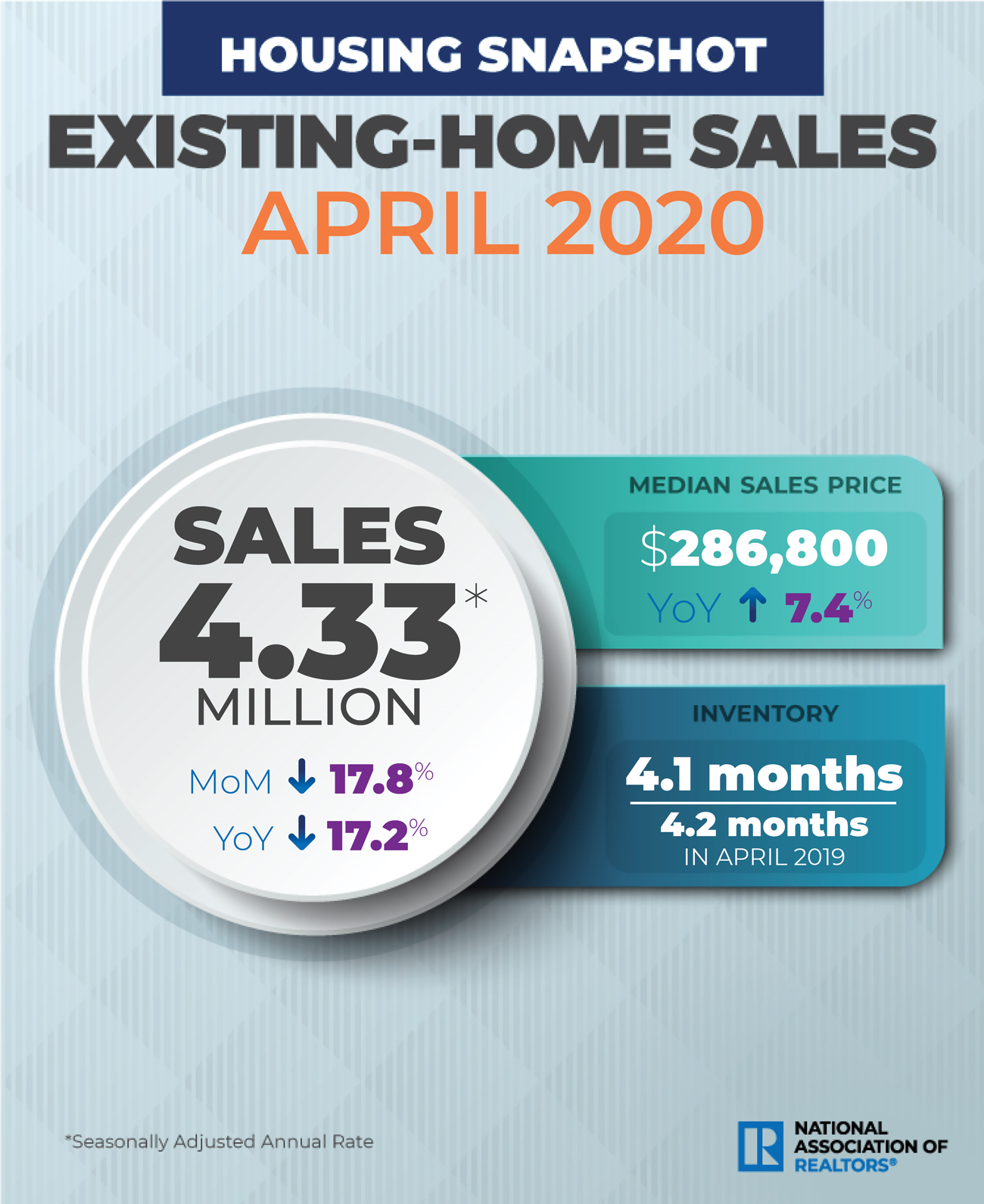
Existing-Home Sales Wane 17.8% in April
WASHINGTON (May 21, 2020) – Existing-home sales dropped in April, continuing what is now a two-month skid in sales brought on by the coronavirus pandemic, according to the National Association of Realtors®. Each of the four major regions experienced a decline in month-over-month and year-over-year sales, with the West seeing the greatest dip in both categories.

Total existing-home sales,1 https://www.nar.realtor/existing-home-sales, completed transactions that include single-family homes, townhomes, condominiums and co-ops, dropped 17.8% from March to a seasonally-adjusted annual rate of 4.33 million in April. Overall, sales decreased year-over-year, down 17.2% from a year ago (5.23 million in April 2019).
“The economic lockdowns – occurring from mid-March through April in most states – have temporarily disrupted home sales,” said Lawrence Yun, NAR’s chief economist. “But the listings that are on the market are still attracting buyers and boosting home prices.”
April’s existing-home sales are the lowest level of sales since July 2010 (3.45 million) and the largest month-over-month drop since July 2010 (-22.5%).2
The median existing-home price3 for all housing types in April was $286,800, up 7.4% from April 2019 ($267,000), as prices increased in every region. April’s national price increase marks 98 straight months of year-over-year gains.
“Record-low mortgage rates are likely to remain in place for the rest of the year, and will be the key factor driving housing demand as state economies steadily reopen,” Yun said. “Still, more listings and increased home construction will be needed to tame price growth.”
Total housing inventory4 at the end of April totaled 1.47 million units, down 1.3% from March, and down 19.7% from one year ago (1.83 million). Unsold inventory sits at a 4.1-month supply at the current sales pace, up from 3.4-months in March and down from the 4.2-month figure recorded in April 2019.
Properties typically remained on the market for 27 days in April, seasonally down from 29 days in March, but up from 24 days in April 2019. Fifty-six percent of homes sold in April 2020 were on the market for less than a month.
First-time buyers were responsible for 36% of sales in April, up from 34% in March 2020 and 32% in April 2019. NAR’s 2019 Profile of Home Buyers and Sellers – released in late 20195 – revealed that the annual share of first-time buyers was 33%.
Individual investors or second-home buyers, who account for many cash sales, purchased 10% of homes in April, down from 13% in March 2020 and from 16% in April 2019. All-cash sales accounted for 15% of transactions in April, down from 19% in March 2020 and 20% in April 2019.
Distressed sales6 – foreclosures and short sales – represented 3% of sales in April, about even with both March 2020 and April 2019.
While virtually every sector of the American economy has been hit hard by this pandemic, our nation’s 1.4 million Realtors® have continued to show an undying commitment to their profession, their clients and America’s real estate industry,” said NAR President Vince Malta, broker at Malta & Co., Inc., in San Francisco, Calif.
“As we find during any time of crisis, we have a tremendous opportunity to evolve and emerge stronger and more efficient,” Malta continued. “Having renewed our focus on new, innovative ways to serve American consumers, I am confident the real estate sector and our nation’s Realtors® are uniquely positioned to lead America’s economic recovery.”
Realtor.com®’s Market Hotness Index, measuring time-on-the-market data and listing views per property, revealed that the hottest metro areas in April were Colorado Springs, Colo.; Fort Wayne, Ind.; Topeka, Kan.; Pueblo, Colo.; and Columbus, Ohio.
According to Freddie Mac, the average commitment rate for a 30-year, conventional, fixed-rate mortgage decreased to 3.31% in April, down from 3.45% in March. The average commitment rate across all of 2019 was 3.94%.
Single-family and Condo/Co-op Sales
Single-family home sales sat at a seasonally-adjusted annual rate of 3.94 million in April, down 16.9% from 4.74 million in March, and down 15.5% from one year ago. The median existing single-family home price was $288,700 in April, up 7.3% from April 2019.
Existing condominium and co-op sales were recorded at a seasonally adjusted annual rate of 390,000 units in April, down 26.4% from March and down 31.6% from a year ago. The median existing condo price was $267,200 in April, an increase of 7.1% from a year ago.
“There appears to be a shift in preference for single-family homes over condominium dwellings,” Yun said. “This trend could be long-lasting as remote work and larger housing needs will become widely prevalent even after we emerge from this pandemic.”
Regional Breakdown
As was the case for the month prior, April sales decreased in every region from the previous month’s levels. Median home prices in each region grew from one year ago, with the Northeast and Midwest regions showing the strongest price gains.
April 2020 existing-home sales in the Northeast fell 16.9%, recording an annual rate of 540,000, an 18.2% decrease from a year ago. The median price in the Northeast was $312,500, up 8.7% from April 2019.
Existing-home sales decreased 12.0% in the Midwest to an annual rate of 1.10 million, down 8.3% from a year ago. The median price in the Midwest was $229,200, a 9.3% increase from April 2019.
Existing-home sales in the South dropped 17.9% to an annual rate of 1.88 million in April, down 16.8% from the same time one year ago. The median price in the South was $249,400, a 6.4% increase from a year ago.
Existing-home sales in the West fell 25.0% to an annual rate of 810,000 in April, a 27.0% decline from a year ago. The median price in the West was $419,300, up 6.1% from April 2019.
The National Association of Realtors® is America’s largest trade association, representing more than 1.4 million members involved in all aspects of the residential and commercial real estate industries.
# # #
For local information, please contact the local association of Realtors® for data from local multiple listing services (MLS). Local MLS data is the most accurate source of sales and price information in specific areas, although there may be differences in reporting methodology.
NOTE: NAR’s Pending Home Sales Index for April is scheduled for release on May 28, and Existing-Home Sales for May will be released June 22; release times are 10:00 a.m. ET.
1 Existing-home sales, which include single-family, townhomes, condominiums and co-ops, are based on transaction closings from Multiple Listing Services. Changes in sales trends outside of MLSs are not captured in the monthly series. NAR rebenchmarks home sales periodically using other sources to assess overall home sales trends, including sales not reported by MLSs.
Existing-home sales, based on closings, differ from the U.S. Census Bureau’s series on new single-family home sales, which are based on contracts or the acceptance of a deposit. Because of these differences, it is not uncommon for each series to move in different directions in the same month. In addition, existing-home sales, which account for more than 90% of total home sales, are based on a much larger data sample – about 40% of multiple listing service data each month – and typically are not subject to large prior-month revisions.
The annual rate for a particular month represents what the total number of actual sales for a year would be if the relative pace for that month were maintained for 12 consecutive months. Seasonally adjusted annual rates are used in reporting monthly data to factor out seasonal variations in resale activity. For example, home sales volume is normally higher in the summer than in the winter, primarily because of differences in the weather and family buying patterns. However, seasonal factors cannot compensate for abnormal weather patterns.
Single-family data collection began monthly in 1968, while condo data collection began quarterly in 1981; the series were combined in 1999 when monthly collection of condo data began. Prior to this period, single-family homes accounted for more than nine out of 10 purchases. Historic comparisons for total home sales prior to 1999 are based on monthly single-family sales, combined with the corresponding quarterly sales rate for condos.
2 In September 2011, sales also fell to 4.33 million.
3 The median price is where half sold for more and half sold for less; medians are more typical of market conditions than average prices, which are skewed higher by a relatively small share of upper-end transactions. The only valid comparisons for median prices are with the same period a year earlier due to seasonality in buying patterns. Month-to-month comparisons do not compensate for seasonal changes, especially for the timing of family buying patterns. Changes in the composition of sales can distort median price data. Year-ago median and mean prices sometimes are revised in an automated process if additional data is received.
The national median condo/co-op price often is higher than the median single-family home price because condos are concentrated in higher-cost housing markets. However, in a given area, single-family homes typically sell for more than condos as seen in NAR’s quarterly metro area price reports.
4 Total inventory and month’s supply data are available back through 1999, while single-family inventory and month’s supply are available back to 1982 (prior to 1999, single-family sales accounted for more than 90% of transactions and condos were measured only on a quarterly basis).
5 Survey results represent owner-occupants and differ from separately reported monthly findings from NAR’s Realtors® Confidence Index, which include all types of buyers. Investors are under-represented in the annual study because survey questionnaires are mailed to the addresses of the property purchased and generally are not returned by absentee owners. Results include both new and existing homes.
6 Distressed sales (foreclosures and short sales), days on market, first-time buyers, all-cash transactions and investors are from a monthly survey for the NAR’s Realtors® Confidence Index, posted at nar.realtor.
Source: "Existing-Home Sales Wane 17.8% in April"











Comments